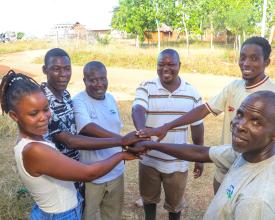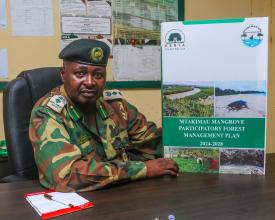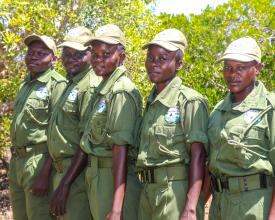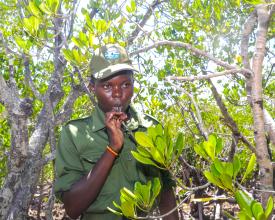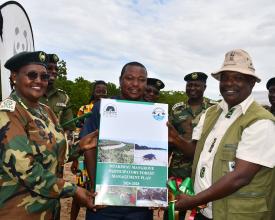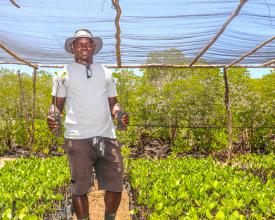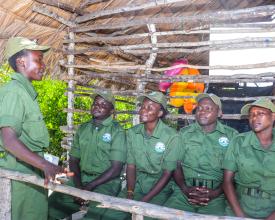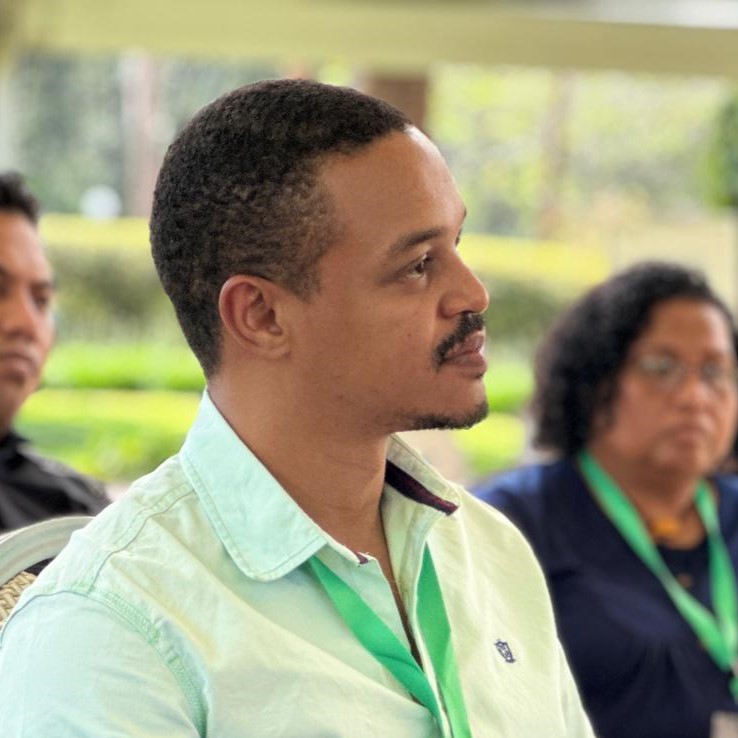
Strengthening Community Governance for Sustainable Mangrove Restoration in Kilifi, Kenya

In the south of Kilifi County, Kenya, deforestation pressures intensified by the COVID-19 pandemic led to extensive degradation of mangrove ecosystems. In response, WWF-Kenya, through the Bengo Project, partnered with the Kenya Forest Service and the Mtwapa, Takaungu, and Kilifi Community Forest Associations (CFA) to restore these vital landscapes. This solution focused on revitalizing community governance by restructuring the CFA, building local capacity through training on governance and leadership, and developing a Mangrove Participatory Forest Management Plan. Other actions included supporting community-managed mangrove nurseries and deploying trained community scouts. The initiative restored 47 degraded mangroves, enhanced community ownership, improved local livelihoods, and increased resilience to climate change, demonstrating how empowering local institutions can lead to long-term ecosystem recovery.
Contexte
Défis à relever
The Bengo project addressed key environmental, social, and economic challenges. Ecological degradation, driven by illegal logging and salinisation, has led to mangrove loss, biodiversity decline, and reduced natural protection against tidal waves and tsunamis. Socially, the Mtakimau CFA suffered from weak governance and low community engagement, which worsened forest loss during COVID-19 as communities increasingly depended on natural resources. Economically, a lack of alternative income opportunities pushed locals to exploit mangroves unsustainably, deepening poverty and land degradation. Strengthening community governance and promoting ecosystem restoration were crucial steps in reversing these challenges and building resilience.
Emplacement
Traiter
Résumé du processus
Strengthening governance through the restructuring of the Mtakimau Community Forest Association (CFA) provided the foundation for all subsequent restoration efforts. With an empowered and organised CFA, the development of the Participatory Forest Management Plan (PFMP) aligned community aspirations with sustainable mangrove management goals. Community nurseries were then established to supply seedlings essential for achieving the PFMP’s restoration targets. Deployment of trained community scouts ensured regular patrols, protection of restored areas, and continued community sensitisation. Each step complements the next: strong governance enables strategic planning, which in turn guides restoration efforts; nurseries provide the necessary restoration materials; and scouts secure conservation gains. Together, these interconnected actions deliver long-term, community-driven mangrove restoration and protection.
Blocs de construction
Strengthening Community Governance through CFAs
The Mtakimau Community Forest Association (CFA) was revitalized through restructuring and targeted governance capacity building. Transitioning from loosely organized village-based groups to formal individual membership improved accountability, transparency, and inclusive participation. Sixty grassroots leaders were trained on leadership, resource mobilization, conflict management, and forest legislation. Democratic elections established both a management and executive committee. Additionally, sessions on Environmental and Social Safeguards and grievance mechanisms were delivered, enhancing the CFA’s capacity to manage mangrove resources sustainably. This transformation fostered local ownership and positioned the CFA as a credible, community-led institution supporting long-term mangrove restoration and conservation in Kilifi County.
Facteurs favorables
- Active collaboration between KFS, WWF-Kenya, and the local government (County Government of Kilifi) ensured technical and institutional support.
- Inclusive community engagement through village meetings (barazas), elections, and training built trust and ownership.
- The existence of supportive laws (e.g. Forest Conservation and Management Act 2016) enabled formal recognition of CFAs and structured community involvement.
- Targeted training enhanced leadership, governance, and resource mobilization capacities.
- Clear governance structures and visible restoration outcomes reinforced accountability and motivation.
Leçon apprise
- Early and consistent stakeholder engagement builds credibility and fosters smoother implementation.
- Transparent elections and defined roles strengthen governance and accountability in CFAs.
- Capacity building must be context-specific and continuous to sustain effective community leadership.
- Legal recognition and structured organization empower CFAs to access rights and resources.
- Visible restoration benefits increase community motivation and commitment to long-term conservation.
Participatory Forest Management Planning (PFMP) AND AGREEMENTS
The MTAKIMAU Mangrove Participatory Forest Management Plan (PFMP) 2024–2028 guides the sustainable management of approximately 2,550 hectares of mangrove forest across Mtwapa, Takaungu, and Kilifi. Developed under Section 47(1) of the Forest Conservation and Management Act (2016), the plan resulted from a highly participatory process led by the Mtakimau Community Forest Association (CFA), in collaboration with the Kenya Forest Service (KFS), WWF-Kenya, and other local stakeholders.
The process began with community barazas that restructured and registered the CFA. Stakeholders then formed and trained a Local Planning Review Team (LPRT), which conducted forest assessments, household surveys, participatory mapping, and community dialogues. Together, they designed the PFMP to define sustainable forest use practices, identify conservation priorities, and establish equitable benefit-sharing mechanisms. The plan reflects community aspirations, ensures ecological integrity, and builds climate resilience. KFS and the CFA formalized their partnership by signing a legally binding Forest Management Agreement (FMA) based on this plan.
Facteurs favorables
- Strong institutional collaboration between KFS, WWF-Kenya, the County Government of Kilifi, and local communities ensured technical and administrative support.
- Early and inclusive community engagement, including village barazas and user group formation, fostered ownership and trust.
- Capacity building of the Local Planning Review Team (LPRT) empowered community members to lead surveys, mapping, and planning activities.
- Legal backing under the Forest Conservation and Management Act (2016) provided a clear framework for community participation and co-management.
- Adequate financial and technical support from the Bengo Project (funded by BMZ through WWF-Kenya) enabled thorough data collection and plan development.
Leçon apprise
- Early community involvement builds ownership and leads to more inclusive, practical management plans.
- Training local representatives (LPRT) creates lasting capacity for community-led planning and decision-making.
- Legal recognition of community forest associations (CFAs) is essential for formal co-management and accountability.
- A multi-stakeholder approach strengthens the legitimacy, resource mobilization, and technical quality of the plan.
- Field-based data collection and participatory mapping ensure that community knowledge and local realities shape the final plan.
Community-Based Mangrove Nursery Establishment and Restoration Activities
MTAKIMAU CFA members, supported by WWF-Kenya and the Kenya Forest Service (KFS), took the lead in restoring degraded areas across the 2,550-hectare Mtwapa-Takaungu-Kilifi mangrove landscape. They established a model mangrove nursery in Nzombere Village and received hands-on training in propagating indigenous species, nursery management, and enrichment planting. Using insights from PFMP mapping, they prioritized degraded patches for restoration. In June 2024, the community planted 21,786 seedlings—WWF-Kenya purchased 13,786 while the CFA contributed 8,000. The nursery, now producing over 10,000 seedlings, serves as both a restoration hub and a sustainable income source through seedling sales to restoration partners. Ongoing monthly monitoring ensures nursery health and supports long-term forest regeneration.
Facteurs favorables
- Strong collaboration among Mtakimau CFA, WWF-Kenya, and KFS provided consistent technical, financial, and logistical support.
- Tailored capacity building empowered community members to manage nurseries and conduct restoration independently.
- Participatory PFMP mapping ensured restoration targeted ecologically and socially important degraded sites.
- Clear benefit-sharing structures motivated active participation and ensured community groups received income from seedling sales.
- Regular monitoring and support reinforced accountability and improved nursery performance.
Leçon apprise
- Engaging communities early and consistently builds strong ownership and ensures the success of restoration efforts.
- Training community members in nursery management and restoration techniques equips them to lead and sustain restoration activities.
- Using participatory forest management planning to identify degraded sites ensures restoration responds to local priorities and ecological needs.
- Structuring seedling sales with fair benefit-sharing motivates community participation and supports local livelihoods.
- Conducting regular monitoring fosters accountability, maintains nursery quality, and improves long-term restoration outcomes.
Establishment and Empowerment of Mtakimau CFA Community Scouts
To strengthen mangrove protection and community-based monitoring, twelve community scouts were selected and trained from within the Mtakimau Community Forest Association (CFA). Equipped with uniforms, patrol skills, communication tools, and basic enforcement knowledge, the scouts actively support restoration, surveillance, and awareness-raising across the 2,550-hectare mangrove area. Scouts conduct regular patrols, detect illegal activities, sensitize local communities about forest conservation, and collaborate with Kenya Forest Service (KFS) officials for enforcement actions. Their work enhances ground-level presence and helps bridge the gap between formal forest authorities and the community.
Facteurs favorables
- Technical training and operational support provided by KFS and WWF-Kenya.
- Provision of uniforms and incentives (such as meals during patrols) to motivate scouts.
- Strong community buy-in and recognition of scouts as ambassadors for conservation.
- Clear roles and integration into the Participatory Forest Management Plan (PFMP).
Leçon apprise
- Offering logistical support and small incentives (like meals or stipends) sustains scout engagement over time.
- Early training on conflict resolution and community relations improves patrol effectiveness.
- Recognition and visibility (uniforms, public introductions) boost scout credibility within the community.
- Scouts' work should be embedded into broader conservation and enforcement strategies to avoid isolation or burnout.
Impacts
The Mtakimau Mangrove Restoration and Governance Project has achieved strong environmental, social, and economic results. Environmentally, about 2,550 hectares of mangrove forests in Mtwapa, Takaungu, and Kilifi are now managed under a participatory framework, supporting the conservation of biodiversity and coastal resilience. Restoration activities recorded an 80% seedling survival rate, while the deployment of 12 trained community scouts has helped reduce illegal cutting and strengthened forest protection.
Socially, the restructuring of the Mtakimau Community Forest Association (CFA) empowered local leadership, enhanced governance, and raised conservation awareness across more than 100 community households through meetings, trainings, and surveys. Economic impacts include the establishment of community-run mangrove nurseries, creating livelihood opportunities for youth and women’s groups through seedling production and future restoration contracts.
The project has fostered community pride, improved coastal ecosystem services, and enhanced resilience against climate risks for adjacent communities.
Bénéficiaires
CFA members, youth and women’s groups, fishers, farmers, and the eco-tourism user group benefited through improved livelihoods, training, stronger governance, restored mangrove ecosystems, and enhanced resilience to climate change.
Cadre mondial pour la biodiversité (CMB)
Objectifs de développement durable
Histoire
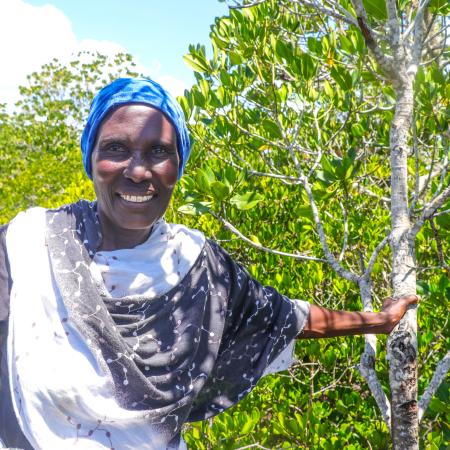
A Story from the Chairman of Mtakimau Community Forest Association (CFA)
Elijah Chivatsi
Back in 2011, something powerful happened in Kilifi. Fourteen villages came together with a common dream: to protect our forests and uplift our livelihoods. That’s how the Mtakimau Community Forest Association (CFA) was born. By 2014, we were officially registered and had started off with great energy. We even launched small activities like brickmaking and some conservation work, led by passionate members like Mama Grace Chonyi, the first CFA chairman.
But I’ll be honest, the road wasn’t smooth. Without proper financial and technical support, we struggled. Slowly, momentum faded, and by 2020, the CFA had gone quiet. Most of us lost hope.
Then came June 2023, a real turning point for us. WWF-Kenya, through the BENGO project, stepped in. With their help, we held awareness forums, elected new leaders, and restructured ourselves under one license. That allowed all the user groups to work together as one strong unit, instead of scattered self-help teams.
We received practical training in leadership, forest governance, financial literacy, conflict resolution, monitoring, and communication. With renewed purpose, we developed a new Participatory Forest Management Plan (PFMP), carried out field surveys, and signed a Forest Management Agreement with the Kenya Forest Service (KFS). For the first time, we had legal rights to manage our forest and develop sustainable livelihood projects.
One of the most beautiful changes I’ve seen is around women’s inclusion. In our community, especially among Muslim families, women rarely took part in forest activities. But through continued sensitisation, that has changed. Today, women are actively involved in mangrove restoration, running tree nurseries, beekeeping, even mushroom farming.
Now, Mtakimau CFA is working to restore degraded mangrove areas across three creeks in Kilifi. Our people are not only protecting the forest, they’re taking ownership of it. Surveillance efforts have improved, and you’ll often see our members working side by side with KFS officers.
Before this, many in the community relied on cutting trees and other unsustainable practices just to get by. But now, our degraded areas are slowly coming back to life. We’re even writing proposals, reaching out to donors, and building networks to ensure our work lasts beyond this project.
This CFA is no longer just a group. It’s a symbol of resilience, renewal, and a community finding its way back to harmony with nature.

